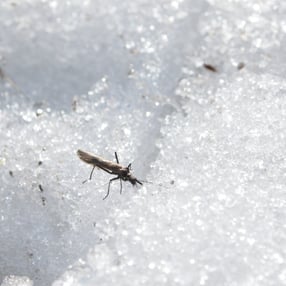
Beautiful butterflies fly from flower to flower looking for nectar; grasshoppers hop around clicking as they go; and dragonflies fly close to ponds and other water sources in search of mosquitos and tadpoles. However, as the days get shorter and the temperature starts to drop, fewer and fewer insects are seen out and about. Now we are deep into winter, so where do the insects go when the weather becomes cold and snowy? Like all plants and animals in the mountains, insects have adapted to survive winter in a variety of ways.
Walking in the winter is often a much more quiet experience than in the spring and summer. The chirps and clicks of insects like the grasshopper may not be audible but it does not mean they are completely gone. Colorado winters are too cold for adult grasshoppers but specially adapted eggs ensure the next generation of grasshoppers can survive. Firstly, mother grasshoppers have an egg-laying organ that is shaped like a knife to help dig deeper into the ground. Burying the eggs deeper underground better protects them from both pests and the elements. Additionally, these special eggs are covered with a gummy coating that hardens and binds the eggs together to help them withstand the harsh winter conditions. Laying in wait for months, when the sun comes out and starts to warm the soil, the eggs will hatch and soon the familiar, clicking cacophony will resume. Grasshopper eggs lay dormant, but some insects stay active below the ice and snow.
Under the ice of Colorado’s frozen lakes and ponds are whole worlds teeming with insect life. Many insects, including the dragonfly, live under the ice in their larval stage as nymphs until the spring. Unlike other insects, these dragonfly nymphs are very active during the winter. The nymphs continue to feed and grow throughout the cold months until they are strong enough for the spring when they will emerge as adults. However, not all dragonflies are created equal. Some dragonflies leave Colorado and migrate to spend their winter in the warmer climate of the Gulf of Mexico. Birds are often what comes to mind when talking about migration but dragonflies and other insects also take part in large seasonal journeys.
The magical black and orange monarchs are another Colorado insect that travels in search of warmer weather. Monarchs are tropical insects and at no point in their life cycle can survive freezing temperatures. Each fall, monarchs living west of the Rocky Mountain range instinctively head south to overwinter in their second homes in California along the Pacific coast. Here, monarchs spend the winter living in the perfect climate to avoid winter, using their fat reserves when food sources are scarce. Staying in Colorado would both subject these butterflies to freezing temperatures and force them to burn through their fat reserves too fast to survive until spring. Monarch butterflies only migrate during the day and cluster or roost together at night in order to stay warm. In fact, tens of thousands of monarchs can cluster together on a single tree which can put a lot of stress on the tree’s branches!

Here in the mountains, tree branches are heavy with snow rather than butterflies but as spring warms the slopes, insects will return to the high country. The next time you are out this winter, take a moment to remember the secret world of insects laying in wait through the winter. Whether it be dragonfly nymphs bustling under your feet on a frozen lake or grasshopper eggs laying dormant deep under the snow as you ski; insects may be absent now but they will survive the winter and be back in force come spring.
Dominique Rosario is a Winter Naturalist at Walking Mountains Science Center. In her free time, she loves to learn more about the amazing insects that call Colorado home.
Sources:
https://www.si.edu/spotlight/buginfo/winter
https://www.onlyinyourstate.com/colorado/butterfly-migration-co/
https://www.fs.fed.us/wildflowers/pollinators/Monarch_Butterfly/faqs.shtml
https://monarchjointventure.org/faq/overwintering
https://askdruniverse.wsu.edu/2017/12/06/2826/
https://www.fs.fed.us/wildflowers/pollinators/Monarch_Butterfly/migration/index.shtml








